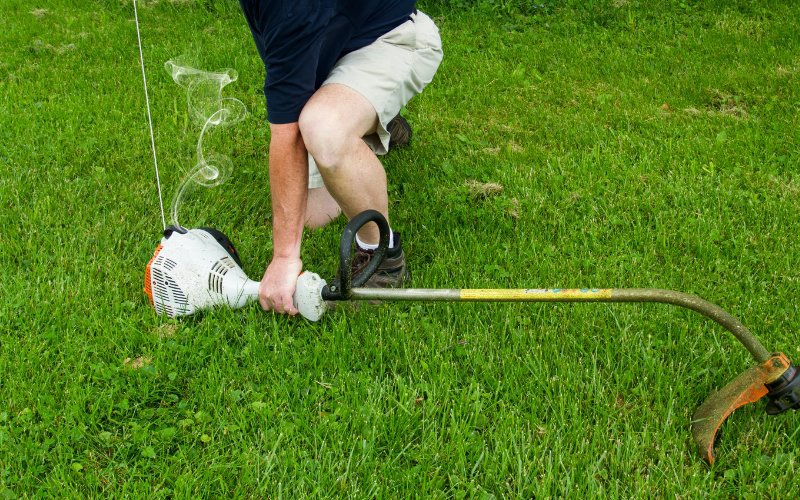When you start your weed eater, you should expect a bit of smoke for a few seconds, but definitely not for too long. So, if you find yourself working around the yard in a cloud of smoke, like out of a scene from an action movie, then something unusual is going on. So, if I were you, I’d put down the weed eater and figure out why your weed eater is smoking.

Why Is My Weed Eater Smoking? (The Short Answer)
Smoke is an indication that there is a problem with the weed eater’s engine and that it should be stopped immediately. Various colors of smoke can indicate overheating, a blocked air filter, continued choking, a poor fuel-oil ratio, and old gasoline. A weed eater that is running well and is warm shouldn’t have any smoke coming from the engine.
Weed Eater Is Smoking? (A Closer Look At the Possible Reasons Why)
Now that you know something isn’t wrong because your weed eater is smoking, it’s time to look at the possible reasons why. Here’s a list of the top causes of a weed eater smoking:
- Blocked Air Filter
- Choke is Still ON
- Old Gasoline
- Too Much Oil in the Fuel Mix
- Overheating
Blocked Air Filter
The air filter is responsible for filtering out particles from the air, such as dirt and dust, and preventing them from getting into the carburetor. If the filter does its job correctly, then it will slowly become blocked as it collects dirt and dust.
The knock-on effect of the filter becoming blocked is that it alters the airflow into the carburetor, therefore, increasing the fuel in the fuel-to-air ratio. As a result, the less air in the mixture, the more smoke. So, pop out your air filter and check if it is blocked.
Choke is Still ON
You’ll need to use the choke when you start your weed eater from cold. The choke enriches the fuel-to-air mixture by increasing the gasoline volume in the combustion chamber while starting to make the process much easier. As a result, there is smoke when you first start your weed eater with the choke on. If this smoking continues a while after you start the weed eater, you should check the position of the choke.
Old Gasoline in the Engine
As gasoline goes bad, it begins to tarnish, and bacteria begin to grow. Aside from all the damage bad gas can do to your weed eater; it gives off smoke when it burns.
If you are concerned that you might have bad gasoline in your weed eater, you should carry out an inspection. If you compare the color of the gas in your weed eater to new fresh gasoline, you might see a color variation. Tarnished gasoline has a much darker color.
Too Much Oil in the Fuel Mix
If you have a two-cycle unit, then you’re familiar with prepping your weed eater gas/oil mixture. These engines rely on oil added to the fuel for lubrication and must be added with every fill. The standard 50:1 mix is flexible to some degree, but not too much.
If you’re not particularly accurate with your mix and overdo the oil, then you’ll get smoke. Now, unless you have a spectroscopy device, you’ll just have to check how much oil you use with your fuel, and ensure you have been using the correct amounts of oil and fuel in your mix.
Overheating
Just like you shouldn’t use too much two-cycle oil, you also shouldn’t use too little. If the engine isn’t lubricated correctly, then the engine is going to get hot. Very hot. As a result, the metal components in the engine will heat up and begin to smoke. So, switch off the engine and check your mix. Again, you’ll need to check what ratio you have been using.
A Summary of What Different Smoke Colors Mean (White, Blue + Black Smoke)
Instead of going through all the different symptoms of your weed eater smoking, you can observe the color of the smoke. For example, white smoke from a trimmer means something different than blue smoke. Here are the different colors of smoke you’ll see and the problems they relate to.
- White Smoke
- Overheating – Not Enough Two-Cycle Oil in the Fuel Mixture
- Blue Smoke
- Too Much Two-Cycle Oil in the Fuel Mixture
- Black Smoke
- Blocked Air Filter
- Old Gasoline
- Choke Still ON
How to Fix a Weed Wacker That Is Smoking
Fortunately, if you spot the smoke early and stop your weed eater, you shouldn’t have any permanent damage. So, instead of putting up with your weed eater smoking, let’s take a look at the repairs.
Cleaning the Air Filter
To clean the air filter, you’ll first need to remove the air filter cover. So, remove the cover screws using a screwdriver, or if you happen to have a new Stihl or Echo weed eater, you can just remove it by hand. Then, remove the cover and pull out the filter.
If the filter isn’t coated with oil, then you can use an air compressor to blow it out, but if it’s contaminated, you’ll need to replace it. So, take either your new or cleaned filter and place it back into the filter housing. Finally, replace the air filter cover and give the engine a try.
Tools & Parts to Replace a Weed Eater Air Filter
- Screwdriver
- Air Compressor
- Replacement Air Filter if Required
Switching OFF the Choke
If you are used to auto chokes on weed eaters, like the Stihl FS range, then you are used to the choke automatically switching off once you pull on the throttle. But if you have switched over to a different brand, then this feature may not be included.
As a result, if you are using a weed eater without an auto choke, you’ll need to switch it to OFF once the engine has warmed up. If you don’t, you’ll continue to get white smoke from your weed eater, and the engine won’t run well.
Removing the Old Gasoline
To remove the old gas from your weed eater, all you need to do is pour it out into a container and then dispose of it. Once you add fresh gas, the weed eater will take a few minutes to burn off the residual gas in the engine, and the black smoke will stop.
If you make a call to your city offices, they should tell you where you can dispose of the bad gas as part of their local household hazardous waste program.
Getting the Correct Fuel Mixture
I find the easiest way to mix my gasoline is to purchase two-cycle oil that matches my fuel can size. Companies like Echo and Stihl sell two-cycle oil in small containers to make both 2.5-gallon and 5-gallon fuel can mixes. This means you add one bottle of oil to one gas can.
Using this process is much easier and more accurate than trying to measure oil from a large container. Also, if you don’t want to do any mixing, then you can buy premixed two-cycle fuel. Again, Echo and Stihl both manufacture pre-mixed 50:1 fuel to oil for two-cycle engines.


Leave a Reply